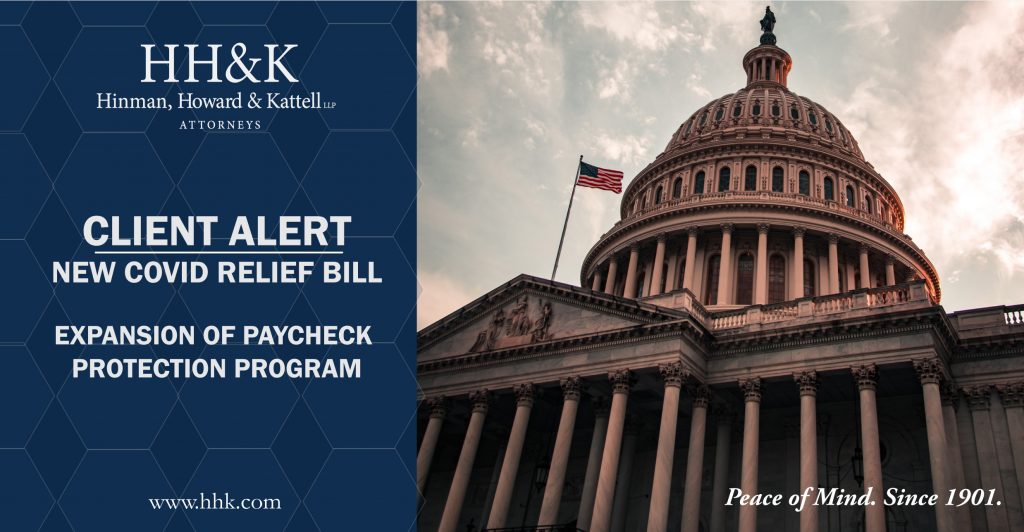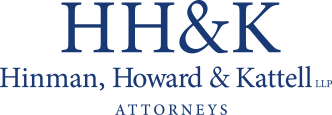
Dear Clients and Friends:
On December 27, 2020, the President signed into law a new bill that includes $900 billion in new COVID-19 relief funding (the “Bill”) intended to provide much-needed economic relief to individuals and businesses impacted by the COVID-19 pandemic. Title III of this Bill, titled the Economic Aid to Hard-Hit Small Businesses, Nonprofits and Venues Act (the “Act”), inter alia, continues and expands the Paycheck Protection Program (“PPP”) established in March under the CARES Act (our prior Client Alerts on the CARES Act can be found here). The Act appropriates more than $284 billion for the PPP. It also expands eligibility for PPP loans, including making some 501(c)(6) not-for-profit organizations eligible for PPP loans for the first time and offering a second round of forgivable PPP loans to eligible businesses that Congress determined to be especially hard-hit by the COVID-19 pandemic.
The Act also establishes that business expenses paid with forgiven PPP loan funds are tax deductible and makes additional borrower-friendly revisions to the PPP, including (a) elimination of rules that reduced PPP loan forgiveness by the amount of any EIDL Advance; (b) expansion of the non-payroll costs eligible for forgiveness; (c) new flexibility regarding the timeframe during which PPP funds can be utilized; and (d) simplified forgiveness procedures for PPP loans up to $150,000.
This Client Alert provides a general summary of the provisions of this new Act related to the Paycheck Protection Program. This information is not legal advice and may not be suitable for all client situations. As always, if you would like specific legal assistance with respect to the PPP or any other matters, please do not hesitate to contact your HH&K attorney.
New Allocation of Funds
As noted above, the Act appropriates more than $284 billion for forgivable PPP loans and it also specifically sets aside certain portions of those funds for particular groups, including first time borrowers, very small businesses and certain smaller lenders. These special allocations include: (1) $35 billion for first-time PPP borrowers ($15 billion of which is specifically set aside for smaller, first-time borrowers with 10 or fewer employees or loans less than $250,000 in low-income areas); (2) $30 billion for first and second draw PPP loans issued by certain smaller lenders; and (3) $25 billion for second draw PPP loans to borrowers with 10 or fewer employees or loans less than $250,000 in low-income areas.
Expansion of Eligibility for the Paycheck Protection Program Loans
First Time Borrowers
The Act expands eligibility for PPP loans and makes “destination marketing organizations” (as defined in the Act) and 501(c)(6) non-profit organizations (other than professional sports leagues and political organizations) eligible for PPP loans for the first time. In order to qualify for PPP loans, these newly eligible entities must (a) have 300 or fewer employees and (b) meet specified limitations regarding lobbying activities.
Businesses that were already eligible for PPP loans under the program requirements in place prior to the Act remain eligible. If an eligible borrower has not yet borrowed under the Paycheck Protection Program, it will be able to obtain a first time PPP loan under the expanded program once the SBA re-opens borrowing.
PPP Second Draw Loans
The Act also establishes a second round of PPP loans (a “PPP Second Draw Loan”) for eligible entities that have already received PPP loans. In order to be eligible for a PPP Second Draw Loan, a borrower must: (1) employ less than 300 employees (vs. 500 for first round PPP loans); (2) have already used (or will use) the full amount their first PPP loan; and (3) demonstrate at least a 25% reduction in gross revenue during any quarter of 2020 relative to the same quarter of 2019 (with certain exceptions with respect to borrowers that were not in business during any or all of 2019).
Each eligible borrower can only receive one PPP Second Draw Loan. The cap for PPP Second Draw Loans is $2,000,000 (vs. $10,000,000 for first round PPP loans). Subject to the $2,000,000 cap, the available loan amount for PPP Second Draw Loans is (a) 2.5x the borrower’s average monthly payroll costs during the last 12 months or during calendar year 2019 (for most eligible borrowers) and (b) for borrowers whose NAICS classification code begins with “72” (e.g. restaurants and hotels), 3.5x the borrower’s average monthly payroll costs. Similar to first round PPP loans, there are different guidelines and rules that can be used by seasonal employers to calculate their maximum loan amount.
Other than the new eligibility requirements and the new rules regarding the maximum loan amount for PPP Second Draw Loans, the rules, regulations, terms and conditions that apply to first round PPP loans (as modified and expanded by the new Act, as further described below) generally also apply to PPP Second Draw Loans. This appears to include the FTE and salary/wage requirements that may reduce loan forgiveness (although the safe harbor and other dates applicable to such requirements will likely need to be updated to the extent those are to be applied to PPP Second Draw Loans). We expect that additional information and clarity regarding the rules applicable to PPP Second Draw Loans will become available as the SBA releases guidance.
PLEASE NOTE: Any business that receives a shuttered venue operator grant under the Act is not eligible for a PPP Second Draw Loan (or for any PPP loan obtained after December 27, 2020). Please see the separate Client Alert, “New Covid Relief Bill – Grants For Shuttered Venues” for more information on this topic, click here.
Expenses Paid with PPP Funds Now Deductible
The new Bill both (1) reaffirms that borrowers will not be taxed on forgiven PPP indebtedness (i.e. forgiven PPP loan funds are not considered part of gross income); and (2) provides that PPP loan forgiveness will not affect the deductibility of any expenses that are otherwise deductible under the Internal Revenue Code. Section 276 of Division N of the Bill provides that “no deduction shall be denied or reduced, no tax attribute shall be reduced, and no basis increase shall be denied, by reason of the exclusion from gross income.” This supersedes the guidance previously issued by the IRS in Notice 2020-32 back in April, which stated that no deduction would be permitted for any expenses paid with forgiven PPP loan funds.
This deductibility rule applies to all borrowers, including those that have already applied for (and/or received) forgiveness. It also applies to all PPP loans, including both first round PPP loans and PPP Second Draw Loans.
Borrowers should also note that whether New York or other states will adopt this deductibility rule regarding expenses paid with forgiven PPP loan funds is not yet clear.
Economic Injury Disaster Loan (EIDL) Program Advances No Longer Reduce PPP Loan Forgiveness
Under the CARES Act, borrowers were required to subtract the amount of any EIDL advance received by the borrower (i.e. advances between $1,000 and $10,000 established by the CARES Act that did not have to be repaid) from the total PPP loan forgiveness to which the borrower was otherwise entitled. The new Act has removed this provision from the CARES Act and, as such, EIDL advances will now not reduce a borrower’s PPP loan forgiveness. In other words, a borrower may now be eligible for full forgiveness of a PPP loan (subject to compliance with other PPP loan requirements) even if the borrower also received an EIDL advance.
The Act provides that the elimination of this provision is to be treated as if it was part of the original CARES Act. Accordingly, unlike various other changes to the PPP implemented by the new Act, this revision applies to all PPP borrowers, even those that have already applied for and/or received PPP loan forgiveness. Further guidance is expected as to how exactly this will be implemented.
Additional Changes to Paycheck Protection Program
The Act also makes various additional changes to the existing Paycheck Protection Program. These changes apply to any loans for which borrowers have not yet applied for forgiveness, including both first round PPP loans and PPP Second Draw Loans, but these changes do not apply to any PPP loans where the borrower has already applied for loan forgiveness.
Expansion of Non-Payroll Costs Eligible for Forgiveness
The Act expands the types of expenses for which PPP loan funds can be used (and forgiven) to include the following non-payroll expenses:
(1) Covered Operations Expenditures for certain business software and services.
(2) Covered Property Damage Costs related to property damage, vandalism or looting due to public disturbances in 2020 that were not covered by insurance or other compensation.
(3) Covered Supplier Costs for purchase of goods essential to business operations made pursuant to certain types of contracts/purchase orders.
(4) Covered Worker Protection expenses for certain purchases of PPE and other equipment necessary to comply with applicable rules and requirements.
PLEASE NOTE: Even though the non-payroll costs eligible for PPP loan forgiveness have been expanded, non-payroll costs are still subject to the 40% limitation (i.e. non-payroll costs cannot exceed 40% of the total costs eligible for forgiveness).
Covered Period Flexibility
Under PPP rules, the only costs eligible for forgiveness are eligible payroll and non-payroll costs paid or incurred during the “covered period”. Under current rules the “covered period” for purposes of loan forgiveness begins on the date of loan origination and ended either 8-weeks or 24-weeks later. Under the changes made by the new Act, Borrowers are no longer locked into an either/or choice between an 8-week covered period or a 24-week covered period. Instead, the Act redefines the term “covered period” for purposes of loan forgiveness to allow borrowers to select a covered period that lasts anywhere from 8 to 24 weeks from the date of loan origination.
Simplified Forgiveness for PPP Loans of $150,000 or Less
The new Act includes a new streamlined loan forgiveness process for those who borrowed up to $150,000 under the PPP. The Act provides that PPP loans of $150,000 or less shall be forgiven if the borrower signs and submits a one-page certification (to be created by the SBA within 24 days following the enactment of the Act) that requires only the following information: (1) a description of the number of employees the borrower was able to retain because of the PPP loan; (2) the estimated amount of the PPP loan amount spent on payroll costs; and (3) the total PPP loan value.
Such borrowers will need to attest (a) that the certification was accurately provided and (b) that the borrower has complied with the PPP loan requirements. In addition, while no supporting documentation must be submitted with the simplified loan forgiveness form, such borrowers are required to retain records related to the PPP loan for 4 years (in the case of employment records) or 3 years (for all other PPP loan records) following submission of the forgiveness form. The Act further provides that these borrowers will only be subject to audit by the SBA in the event of fraud, ineligibility, or improper use of loan proceeds.
Contact Your HH&K Attorney for Legal Guidance
This information is not legal advice and may not be suitable for all client situations. This Client Alert provides general information regarding the Grant Program and does not outline all of the important considerations related thereto. The Act directs the SBA to issue regulations to carry out the Act within 10 days after the bill was signed into law by the President. We anticipate that the terms of this program may continue to evolve as the SBA releases guidance.
This Client Alert is not a substitute for legal guidance regarding program details and how those may be applicable to your business. As always, if we can be of assistance during this difficult time, please do not hesitate to contact your HH&K attorney.

| Erica L. Lawson Partner 80 Exchange Street Binghamton, NY 13901 Phone: (607) 231-6907 Email: elawson@hhk.com |
Copyright © 2021 by Hinman, Howard & Kattell LLP. This Client Alert is provided as a general information service to clients and friends of Hinman, Howard & Kattell, LLP. It should not be construed as, and does not constitute legal advice on any specific matter, nor does this message create an attorney-client relationship. These materials may be considered Attorney Advertising in some states.
